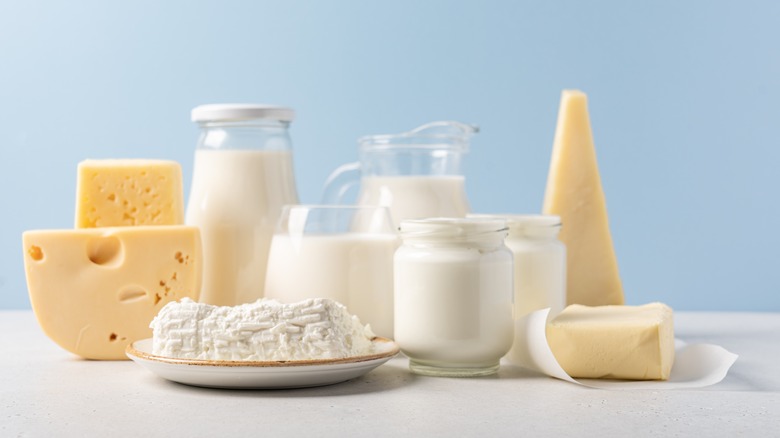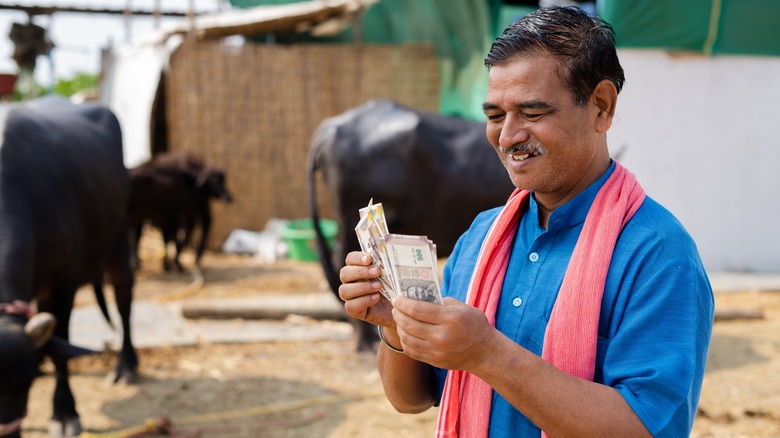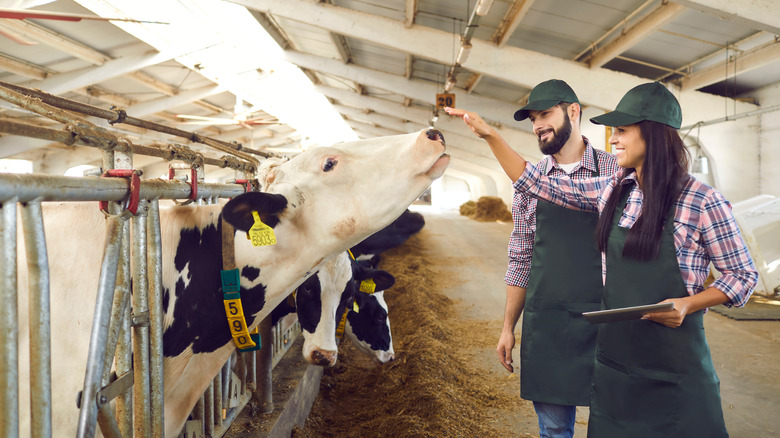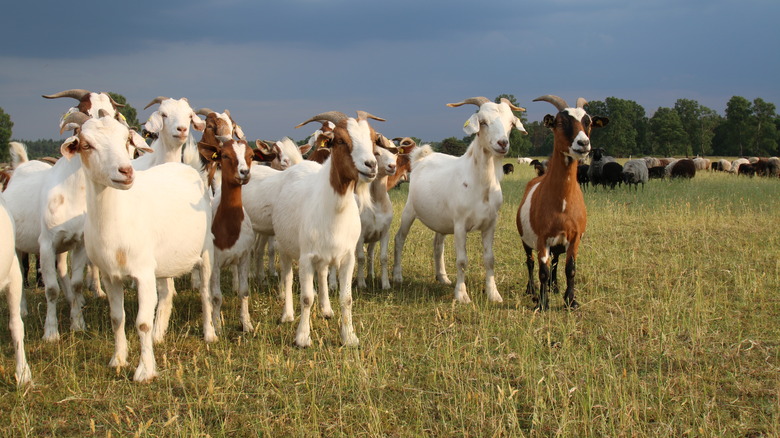Most Of The World's Dairy Comes From This Country
Correction 10/7/22: A previous version of this article stated the average dairy farm in the U.S. has 15,000 cows. While the USDA reports many of the larger dairy farms in the U.S. are home to 15,000 cows or more, the average number of cows per dairy farm in the U.S. is between 1,000 and 5,000.
Milk is the foundation of all dairy products, including butter, heavy cream, buttermilk, yogurt, ghee, half-and-half, all types of cheese, and much more. Since dairy products are necessary for so many people, it's hard to imagine how many dairy facilities are required to feed the demands of today's world. According to the Food and Agriculture Organization of the United Nations (FAO), it's estimated that 150 million households around the world work in some scale of milk production, and from 1988 to 2018, the world has increased their production by over 60 percent, more specifically from about 585 million tons to just shy of 930 million tons.
If you grew up in the United States in the 90s/early 2000s, you were most likely encouraged to have a glass of milk with every meal and were inundated with "Got Milk?" campaigns featuring your favorite celebrities with milk mustaches, per Mental Floss. This particular campaign was enacted because soft drinks and sports drinks were gunning for milk's spot at the dinner table. Given this information, you may assume that the United States would be the leading producer of dairy, but they actually come in at a close second place, per FAO.
India produces the most milk worldwide
India leads the world in milk production, accounting for 22% of the global supply (per FAO), but at first, breaking into the dairy industry wasn't easy for the developing nation.
According to a post on LinkedIn, in the midst of India's fight for freedom, Sri Vallabhai Patel was determined to build a future for the country. As a result, in December of 1946, he established a dairy plant called Anand Milk Union Limited (AMUL), without a clue how to do it. After recruiting several people with knowledge of engineering and technology, a system was established. Villagers collected milk, which was transported to AMUL, and then sold for money. Dairy farmers were shareholders, meaning they profited the most.
By 1965, when Lal Bahadur Shastri, Prime Minister of India, noticed this system, he insisted it should be replicated to grow the dairy industry across the country. AMUL was renamed to National Dairy Development Board (NDDB). After negotiation, European countries began supplying NDDB with milk free of charge, in exchange for NDDB to sell, generate funds, and grow the dairy industry.
By the 1970s, NDDB generated 1.2 billion rupees, which would have translated to roughly 150 million U.S. dollars per the exchange rate at the time. Since then, the most growth in milk production worldwide has been seen in countries within South Asia, according to BizVibe.
The United States leads in cow milk production
India edges out the United States in overall milk production because it utilizes milk from both buffalo and cows, according to the USDA. Historically, though, the two countries have had relatively even production levels. In 1997, India took the top spot on the milk podium, kicking the United States off for the first time, with each country producing around 70 million tons each. By 2016, India was the clear industry leader, producing 154 million tons of milk, while the U.S. only produced 96 million tons.
However, it's important to know that the United States is the number one producer of cow's milk in the world (per World Atlas). States like California, Wisconsin, Idaho, New York, and Pennsylvania are the leading producers within the country, with the largest dairy farms in the U.S. often housing more than 15,000 cows each, per a report by the USDA.
On the other hand, 80% of India's production comes from small farmers, with more than 130,000 villages in cooperation. Andhra Pradesh, Gujarat, and Punjab are the top states for production, and the country as a whole is not only first in production, but they're also the lead consumers worldwide.
Is cow milk different from other animal milk?
According to FAO, not only is milk produced by cattle and buffalo, but also by goats, sheep, and camels. The production looks very different depending on the species in terms of feed, water, and climate, which is why a particular type of dairy may be more popular in one country than others.
So the burning question is: Is cow milk different from other types of milk? When comparing cow milk to buffalo milk, Diffen states that buffalo milk is much higher in fat, richer in flavor, lower in cholesterol, higher in calories, and produces creamier substances due to its viscosity, such as yogurt, cottage cheese, and even ghee. Buffalo milk also contains more calcium, which aids in bone health.
According to mbgfood, when comparing goat milk to cow milk, goat milk has more vitamin A, riboflavin, calcium, potassium, and niacin. It also contains small fat globules and less lactose, making it much easier to digest. According to Medium, sheep's milk is the creamiest milk of all, due to its higher fat and protein content. However, it's important to remember that not all types of milk are as easily accessible. A cow can produce 6 to 8 gallons of milk daily compared to a sheep producing a measly half gallon, which alters pricing and availability.



